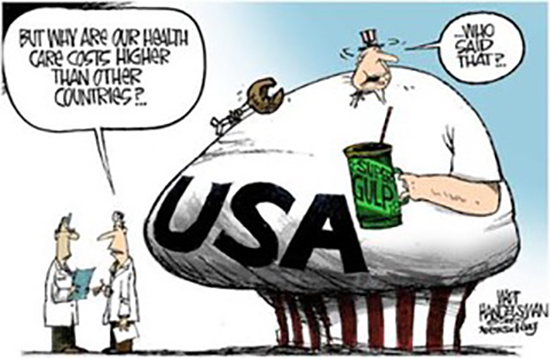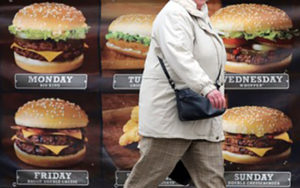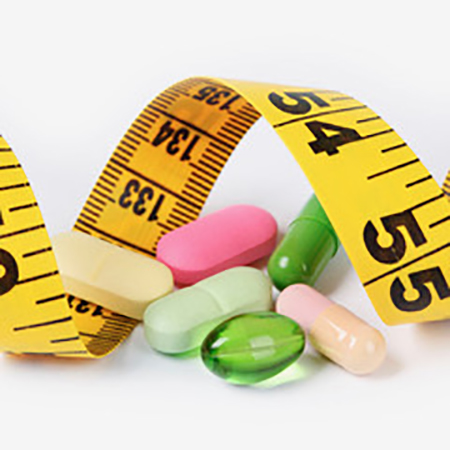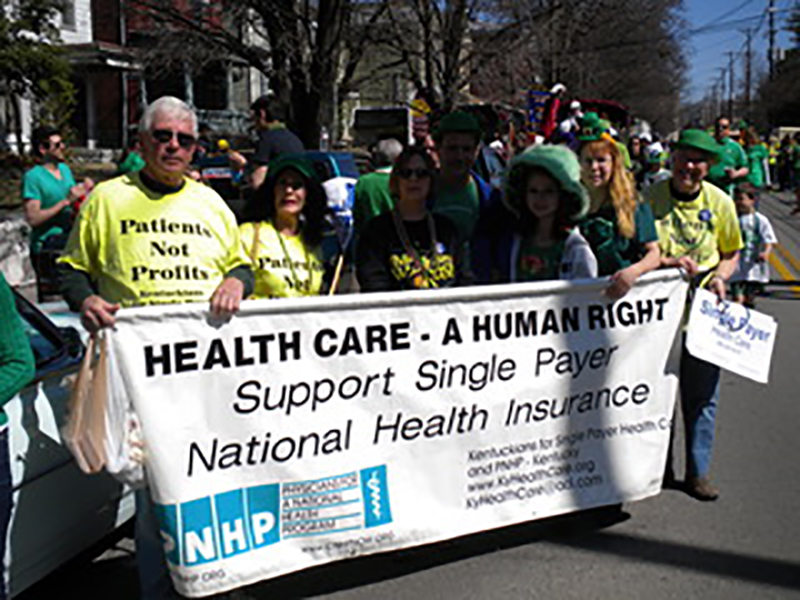The whole world is watching as Americans pack on the pounds. The latest report released by federal health officials last week (March 23), confirms what a 15-minute stroll around any Walmart in America would prove— we’re putting on the pounds at break neck speed. According to the CDC, “obesity is common, serious and costly.” As to “common,” — in 2007-2008, one-third of Americans were obese (BMI of 30 plus). In 2012, a mere four years later, 35.7% of Americans had waddled into the obese category. From that point to today, Americans have been loosening their belts at warp speed.
The March 23rd report revealed two stunning statistics: while fast food sales in the U.S. rose 23% from 2012-2017, 40% of Americans were becoming officially obese (2015-2016) — an increase of 12% in three years. In daily living terms — 4 in 10 of us are too weighted down with extra pounds to get out of bed in the morning without assistance from a device or a loved one. Another third are overweight (BMI of 25). That too has alarming consequences. The vast majority of American adults (three quarters) whiz by the clothing racks selling normal-sized garments to those euphemistically labeled “full figured” or “he-man.” The health consequences are even more dire: three-quarter of American adults are at high risk for diabetes, heart trouble, strokes and certain types of cancer along the road to an untimely passing. The elephant in the room, the statistic that is hardly ever mentioned except in hushed tones — 8% of Americans are severely obese (BMI of 40 or more). As the population gets larger, the health care system struggles to stay abreast. The estimated medical cost of obesity in 2014 was $147.4 billion, a figure that most experts predict will double to $300 billion this year.
America being America you can bet the ranch that someone is profiting by these ungainly pounds. One of the biggest (though not the only) beneficiary is the food industry, both enabler and profiteer. Check this out (preferably before lunch). The average size of a common, garden variety bagel doubled in the 30 years between 1983 and 2003 ballooning from a 3-inch diameter with140 calories to a 6-inch monstrosity weighing in at 350 calories, before you slather on the butter or cream cheese. Who’s behind the big eyes and bigger stomachs consuming these behemoths? The biggest factor is probably “heredity” —this generation’s bad habits becoming the preferred diet of our children’s generation. The national childhood obesity rate is 18.5% (CDC, 10/20/17). Among high school students, 14% are obese and 16% are overweight — close to one-third of American teenagers are affected. Since 1980, childhood obesity has tripled and there is little light at the end of this particular tunnel. Health experts warn that the obesity epidemic among children will take its toll in two ways — 1 in 3 children born in 2003 will develop diabetes in their lifetime. About one-half of childhood obesity victims will need medication to control their rising blood sugar.
Think about it: Children on insulin. Let’s hear a “U.S.A., U.S.A. chant!
America is the exceptional nation on a grander scale. Among developed, highly industrialized nations, in addition to other firsts – highest prison population, most dollars spent on the military, weapons and wars, and that ever-increasing menace — crappy health care, the U.S. is number one in the obesity sweepstakes. (OECD “Obesity Update 2017”)

Not everyone is wringing their hands over the broadening of the American tookus. Champagne corks are popping in the executive suites all over Big Pharma land as what was once a future possibility becomes a profitable reality. Big Pharma (Pharmaceutical Research Manufacturers of America, the lobbying arm of the drug companies) has been handed an exploding business opportunity, along with fatter paychecks for CEO’s, increasing returns for shareholders, a bonanza of bucks for an industry already fat (metaphorically) with profits in our private, negotiation-free health care system.
What’s the reason for all the joy in Pharma-Land? In order to answer that question, let’s take a look at what’s going on all over the world. Americans may be number one when it comes to rising obesity but the global trend is similarly skyward. In the last 30 years, worldwide obesity rates have doubled. Curiously at the same time, blood pressure and cholesterol levels have dropped. That’s where the free market lifts its poisonous and profitable head. Overweight and obese people consume enormous amounts of drugs to stay alive. Their only other option: lose weight. Most opt for drugs. High blood pressure? There’s a pill for that. Cholesterol levels out of whack? You guessed it. Big Pharma will oblige —with another pill; COPD, heart attacks, diabetes, hips and knees that give out – if the drug companies don’t have a pill, the device makers have a prosthetic.
In case your BP or cholesterol levels don’t get high enough to merit a passel of “free” expensive drugs, a panel of “experts,” (translation: doctors, many whose first allegiance is always to their partners in crime, the drug companies) hired by the FDA to set limits for markers like BP and cholesterol will obligingly lower the official “normal” BP and cholesterol levels to reach the levels at which insurance will pay for your meds. You can go on merrily consuming those big Macs and whoppers and not have to worry too much about keeling over waiting for your food.

For those whose rising weight makes it impossible to get around on the limbs Mother Nature provided, there’s a bunch of companies selling scooters and other motorized modes of transportation. As their ads reassure the economically-minded, in most cases your insurance will pay for it. A free scooter and life is blissful again. You will probably put on a few more pounds due to inactivity but Big Pharma has you covered with another pill to stave off death. At least until they find a replacement for that empty chair.
In a health care system where government, the largest purchaser of medicine, is forbidden by law to negotiate prices, don’t expect drug companies to cry alligator tears over sky-rocketing obesity stats. The bigger Americans get, the more profits the companies rake in. Currently only two government agencies are allowed to negotiate prices with drug companies: The Veteran’s Administration and curiously, the Defense Department, which in its other life still buys $37 screws, $7,622 coffee makers, $640 toilet seats. Medicaid negotiates drug prices on a state level but still effectively controls the prices of increasingly expensive drugs. In a 2016 study, Part D, Medicare drug coverage, was found to pay 80% more than the VA and 73% more than Medicaid for an array of the most widely used drugs. Since Medicare recipients pay 25% of the cost of their prescription meds, it’s not only the government’s pocket that’s being picked. Compounding the drug-obesity tie-in, if by 2030 50% of American adults are obese as experts predict, jmagine the sticker price of U.S. healthcare as millions more hop on the obesity train.
When Obama negotiated with the drug companies to formulate the sweetheart corporate give-away masquerading as health care reform, what’s the first thing he agreed to take off the table? Government’s right to negotiate prices with drug companies! While Congress and the White House solemnly proclaim the necessity of cutting Medicare and Medicaid to make it “sustainable,” cutting skyrocketing drug costs gouging our national purse never make it into the conversation.

The effect of a sensible (cost-efficient) federal drug program? In a word: monumental. Lower drug prices make leaner drug companies as serious belt tightening ensues to preserve those precious profit margins investors drool over and CEO bonuses depend upon. When drug prices even for ailments tied to just one condition, obesity, decline a simultaneous decline in pressurized marketing occurs. Have you ever filled a prescription for an antibiotic that’s been around for twenty or thirty years? Instead of $5 or $10 per pill, you’re paying less than $1.00. In the absence of drug company pressure and personal profits, more doctors will steer obese and overweight patients to dieticians, weight loss experts and trainers instead of the pharmacy counter.
When drug companies are no longer able to make enormous profits on their most popular drugs, maybe they will do the decent thing and turn their attention to creating drugs for real diseases like ALS (Lou Gehrig’s disease) rather than the “me-too” drugs that are now the industry standard. How many different cholesterol lowering drugs each with its own little twist does a population need − even one as overweight as ours?
The impossible dream? Not so declared former president Obama “we’ve got to start somewhere.” As with most Obama happy talk, his deeds belied his words and what emerged was a massive ($3.2 trillion) private health care boondoggle rewarding the oligarchs of finance and medicine and consigning the rest of us to the most expensive health care in the developed world that produces mostly mediocre outcomes, including a steady decline in life expectancy (for the last two years) and the number one cause of bankruptcy.
Perhaps the best answer to U.S. health care woes is another question. Are you willing to bet your life to keep drug company coffers filled? “Fool me once, shame on you. Fool me twice, shame on me.” The ACA was the first grand betrayal. Shame on us if we let them get away with another.
Whoever told you the meek inherit the earth was flat out lying.

779 total views, 1 views today

